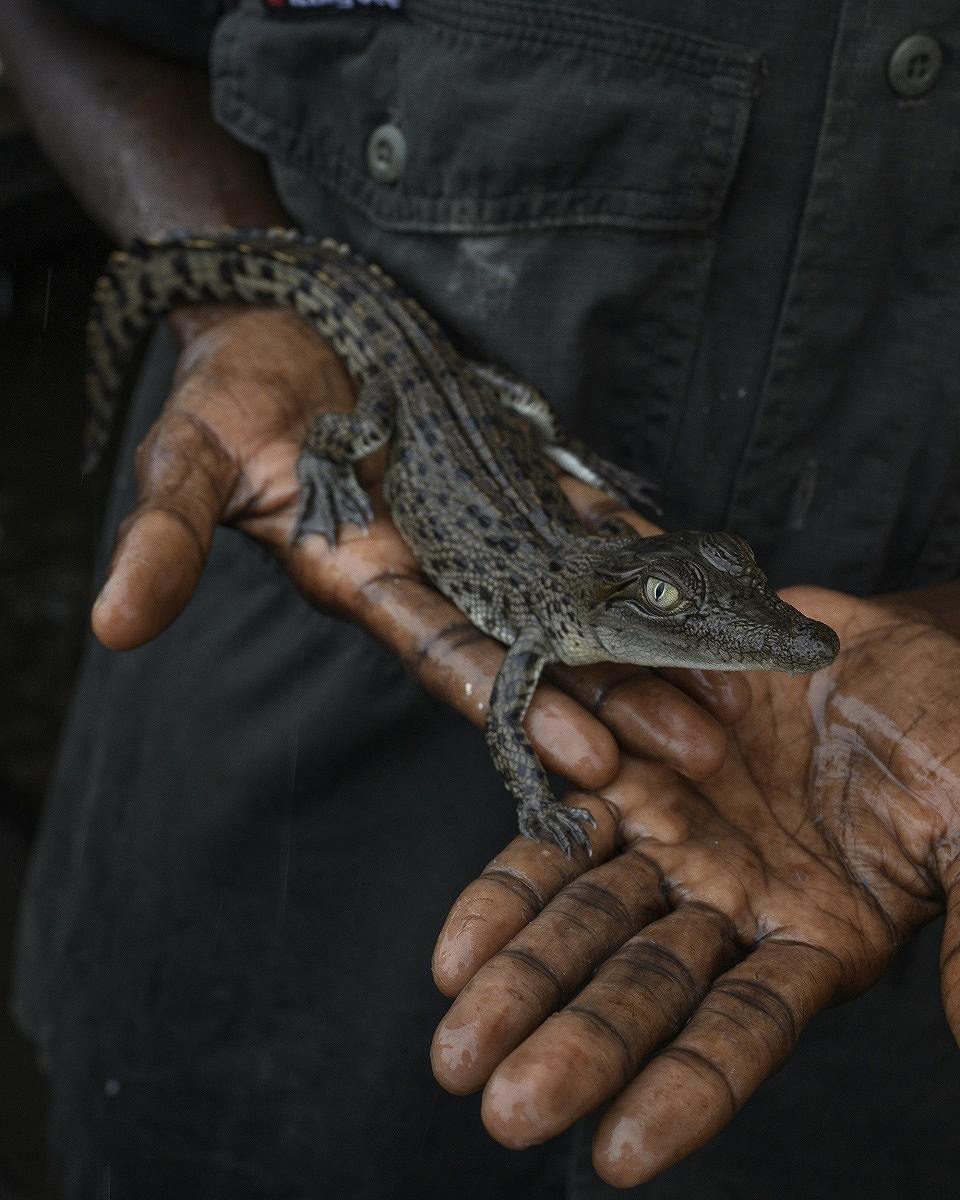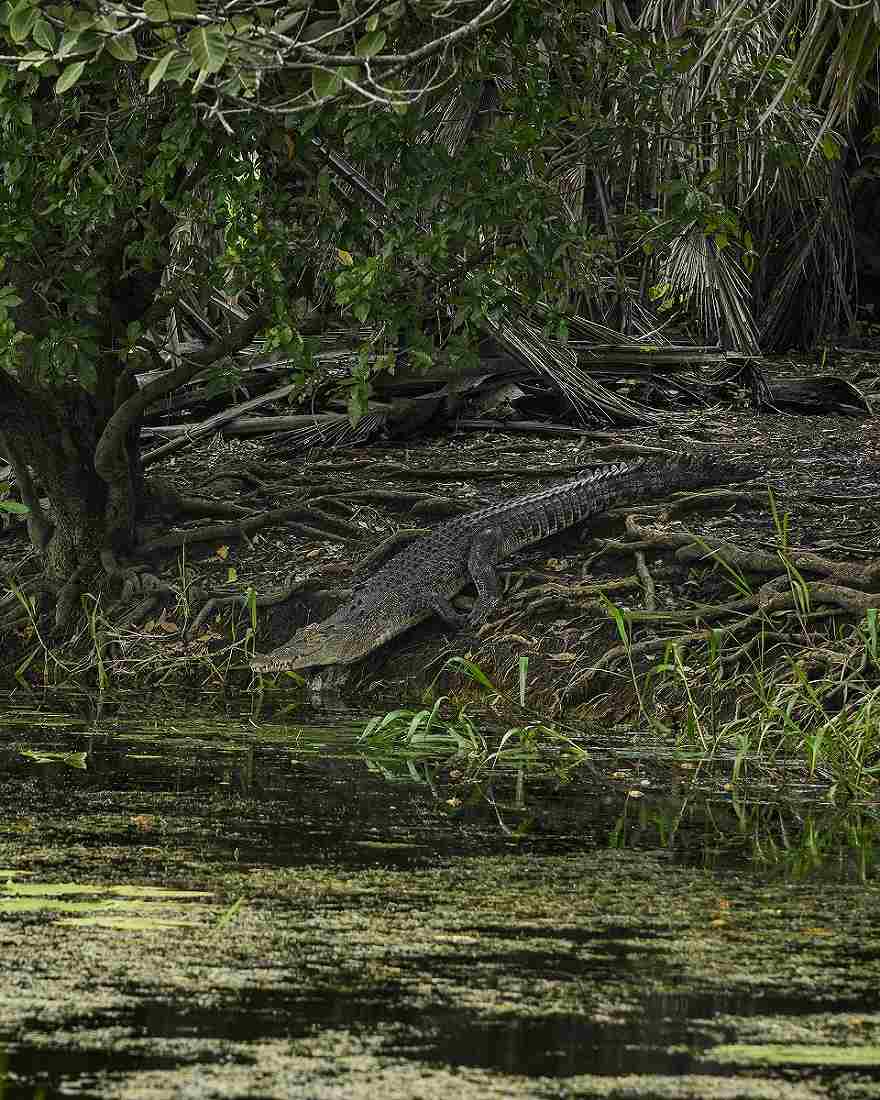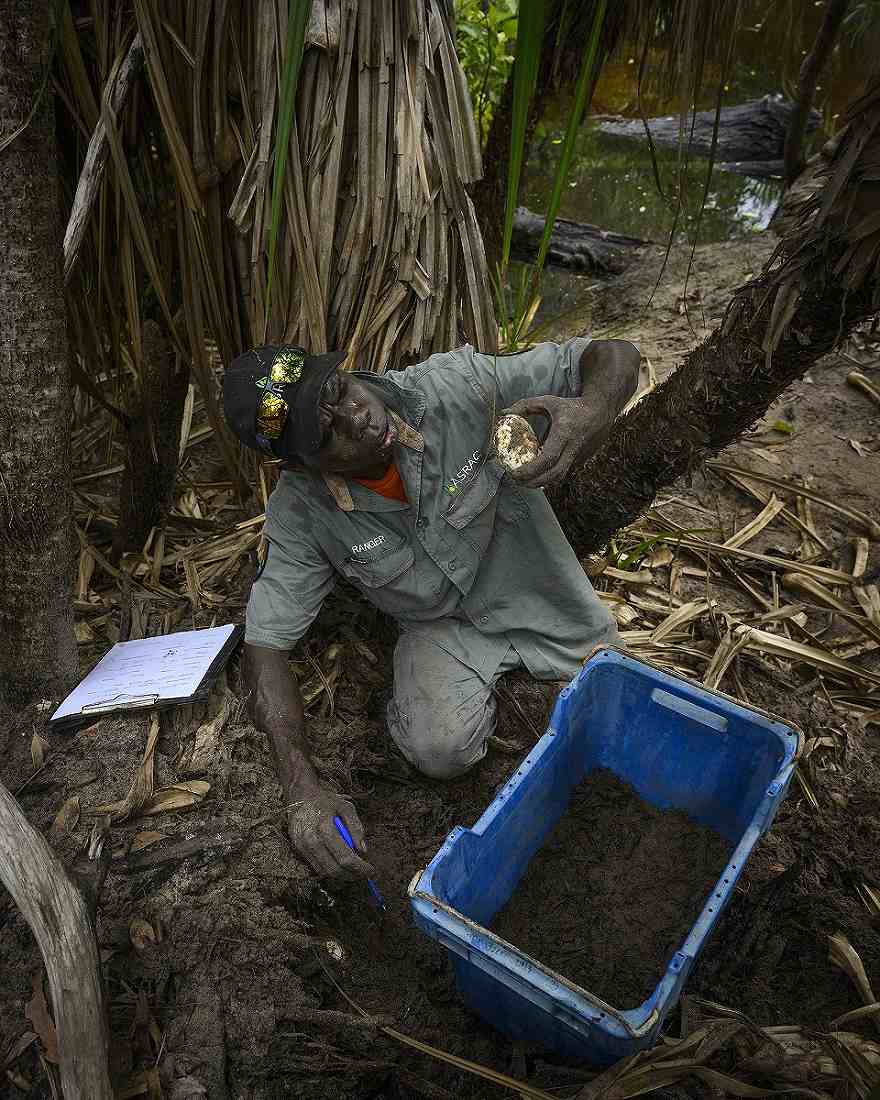
An ASRAC ranger holds a juvenile crocodile.
15:47 JST, September 16, 2023
RAMINGINING, Australia – The rangers had been searching the sweltering forest for days when they, at last, spied a mound of reeds aside the dark and treacherous creek. A crocodile nest.
They whooped with excitement and scrambled over submerged logs to take a look.
Rex Djarrkadama plunged his arms into the mound, probing for the precious objects his Indigenous Yolngu people had hunted for millennia. As he scooped away the dark soil, his hands struck something smooth and white: a crocodile egg.
No sooner had he uncovered it, however, than someone shouted behind him. The creek next to the nest had begun to bubble – a sign that the mother crocodile was approaching.
Djarrkadama turned and froze. Another ranger, Nathanial Maliwanga, slipped the safety off his rifle and aimed at the murky water.
“Keep going,” Maliwanga urged, as his colleague began quickly packing the eggs into a plastic crate. “Keep going!”
Australian crocodile leather is among the most prized on the planet. Fashion giants Hermès and Louis Vuitton use it in some of their designer handbags, which are flashed on the runways of New York, Paris and Milan, and can sell for as much as $50,000.
But the expensive skins have a humble – and hazardous – origin.
Long before they become Birkins, they begin as eggs buried in the swamps and forests here. Obtaining them is one of the most difficult and dangerous jobs Down Under.
For decades, the task often has fallen to Indigenous Australians, who have risked life and limb for little of the reward.
That has started to change, however. As Australia reckons with its violent colonial past, there are growing efforts to keep jobs and profits in Indigenous hands.
Instead of simply transferring the eggs to White farmers, Djarrkadama’s group has begun hatching and raising crocodiles themselves – a first-of-its-kind operation.
“People wanted to bring more value back to the community,” said Helen Truscott, chief executive of the Arafura Swamp Rangers Aboriginal Corporation.
This area produces around 25,000 skins per year worth more than $20 million.
Crocodiles will not usually mate in captivity, so most eggs must be collected in the wild.
Rangers often hunt for eggs with nothing more than a wooden oar, its end scarred by encounters with the apex predator, for protection.
There was, until recently, a practice called “slinging,” in which croc egg hunters hung from helicopters to scoop up their bounty. But slinging was banned after a chopper crash last year killed a TV star and seriously injured his pilot.
The incident has increased scrutiny of a lucrative yet opaque industry.
The Australian government recently announced it was launching a review of the rules governing everything from egg collection and catching wild crocodiles to breeding in captivity and killing methods.
But the slinging ban also has driven up the price of crocodile eggs and the industry’s reliance on Indigenous groups, including the Arafura Swamp Rangers.
In the remote town of Ramingining, where the rangers are based, Aboriginal people have coexisted with crocodiles for millennia. Now, in a confluence of international fashion and local tradition, the ancient animals offer new opportunity.
– – –
Crocodile country

A mid-sized crocodile on the edge of a river bank near Ramingining.
When the water ceased bubbling and it was clear the mother croc had fled, Djarrkadama took his time retrieving the eggs. He removed more than 50 from the nest, carefully packing them in the crate. Before leaving, the men noted the GPS location, which would ensure royalties went to the area’s traditional owners.
The close encounter was not unusual. Along the banks of the Arafura Swamp, crocodiles the size of canoes lie camouflaged amid the mud and mangroves.
At the sound of approaching footsteps, they crash through the pandanus reeds and into the water, leaving only their pale eyes and pointy snouts visible – if anything at all.
The reptiles are part of everyday life here. In nearby Ramingining, everyone knows someone bitten by one.
Ramingining is about as far from the shops and cafes of Sydney or Melbourne as it gets in Australia. It’s not just in the Northern Territory, made famous by the film “Crocodile Dundee,” but in the territory’s tropical coastal region, or “Top End.”
In the dry season from May to October, the town is an eight-hour drive via a croc-infested river crossing from the closest city, Darwin. In the wet season, when monsoons swell rivers and turn the red dirt into knee-deep mud, Ramingining’s 900 or so inhabitants are often cut off for weeks at a time.
The remoteness reinforces the Yolngu’s connection with the land, including its crocs. The animals were here when Indigenous people arrived around 60,000 years ago. They are woven into local songlines, or oral histories. For some Yolngu the crocodile is also their totem: a spiritual connection akin to family.
“The crocodile is not a bad animal,” said Peter Djigirr, 61, a Yolngu elder and Arafura Swamp ranger. His family has existed alongside the reptiles for generations – one ancestor even hunted crocodiles with his bare hands. “We’re related. It’s our culture.”
The past 50 years or so have, however, been challenging.
The animals almost went extinct in Australia as a surge in European demand spurred the widespread slaughter of saltwater crocodiles, whose skin is prized for its supple strength and scale patterns.
By 1970, the number of “salties” in the Northern Territory had fallen from 100,000 to only a few thousand. When the species was protected a year later, the population rebounded. But so did attacks on humans, which in turn triggered croc culls that again threatened the animal’s revival.
To incentivize coexistence, officials turned to the United States, where some southern states had started allowing people to farm or sell alligator eggs found on their property.
A similar system was implemented here, creating a source of revenue for Indigenous peoples, who own almost half the Northern Territory and most of the Top End. They receive royalties for the eggs, but the profits have largely gone to White business owners who hatch, raise, kill and skin the animals on farms near Darwin.
That is slowly starting to change.
Djigirr began working for White farmers in the 1990s, often dangling from a helicopter as he “mucked,” or searched, crocodile nests for eggs.
He began experimenting with hatching the animals a decade ago, starting with an old refrigerator as an incubator and a few small tanks. The trial secured government funding for a proper facility, the only Aboriginal-owned croc-growing operation in Australia.
The hatchery is new for the town, but it suits old cultural practices. When the baby crocs need meat, for example, the rangers hunt water buffaloes.
One afternoon, as their four-wheel-drive vehicles bounced over rugged back roads, Djigirr spotted a calf hidden in the bush and told the rangers to stop.
Maliwanga jumped out and fired a single shot, felling the animal.
The men carved up the buffalo, quickly reducing it to nothing but head, spine and guts. The rangers would keep a few pieces for themselves and feed the rest to the crocodiles back in the tanks at their base in Ramingining.
With that, the rangers had both eliminated an invasive animal that destroys crocodile nesting grounds and found sustenance for their hatchlings.
– – –
From egg to expensive handbag

Djarrkadama collects eggs. A temperature should be taken of the nest to be replaicated at the incubation unit. Over 40 eggs were collected.
Back at their base, the rangers began preparing the eggs they’d collected.
First, they marked the eggs with a pencil to ensure they did not rotate and destroy the fragile crocodile embryos inside.
Then they washed the eggs.
Finally, they put them inside a trailer-sized incubator, where more than 300 eggs already sat in 100-degree heat and humidity that mimicked a nest.
From some of the older eggs, tiny snouts had started to protrude. About 50 small crocodiles that had hatched weeks earlier swam inside four massive tanks.
Every day or two the rangers fed the animals minced buffalo meat, fortified with calcium and vitamins.
The rangers washed the tanks often to remove leftover food and waste.
When the hatchlings are around 9 months old, they will be sent to a bigger farm near Darwin. When they reach roughly four feet in length – the size required for a small handbag – they will be killed. Their soft belly skins will be sent to tanneries in Asia, before ateliers in France turn them into luxury goods.
Last year, the rangers sold 232 hatchlings to the Darwin operation, which business records show is owned by Hermès and Mick Burns, a White farmer often called Australia’s “crocodile king.”
The Darwin operation pays traditional owners in Ramingining about $28 per egg in royalties, and the rangers make $86 per 9-month-old crocodile.
Burns declined to comment, and the rangers said they could not discuss the contract.
Each slaughtered crocodile generates around $750, according to government figures. Some conservationists question whether Indigenous people get a fair share, and animal rights activists claim crocodile farming is unethical.
Hermès and Louis Vuitton did not respond to repeated requests for comment but in its latest annual report, Hermès said it “requires that its partners meet the highest standards for the ethical treatment of alligators and crocodile.” Louis Vuitton has said that all of its tannery suppliers are certified to its standards and it is seeking certification for all crocodile farms supplying the tanneries.
In Ramingining, there is excitement over the hatchery. Children visit as a reward for attending class. The rangers’ outfit is already the biggest employer in town, and is growing.
They hope to triple the number of hatchlings to 1,500 next year. That will mean more ranger jobs and more revenue for the community.
As they drove back to the base one afternoon, Djarrkadama and his uncle, Djigirr, spoke about the future. One day, the rangers hoped to raise crocodiles all the way to slaughter. Djarrkadama dreamed that his young sons would work on the farm, learning from him as he had from his uncle.
“This is the first step of a journey we are on,” he said.
"News Services" POPULAR ARTICLE
-

American Playwright Jeremy O. Harris Arrested in Japan on Alleged Drug Smuggling
-

Japan’s Nikkei Stock Average as JGB Yields, Yen Rise on Rate-Hike Bets
-

Japan’s Nikkei Stock Average Licks Wounds after Selloff Sparked by BOJ Hike Bets (UPDATE 1)
-

Japan’s Nikkei Stock Average Buoyed by Stable Yen; SoftBank’s Slide Caps Gains (UPDATE 1)
-

Japanese Bond Yields Zoom, Stocks Slide as Rate Hike Looms
JN ACCESS RANKING
-

Keidanren Chairman Yoshinobu Tsutsui Visits Kashiwazaki-Kariwa Nuclear Power Plant; Inspects New Emergency Safety System
-

Imports of Rare Earths from China Facing Delays, May Be Caused by Deterioration of Japan-China Relations
-

University of Tokyo Professor Discusses Japanese Economic Security in Interview Ahead of Forum
-

Japan Pulls out of Vietnam Nuclear Project, Complicating Hanoi’s Power Plans
-

Govt Aims to Expand NISA Program Lineup, Abolish Age Restriction






















